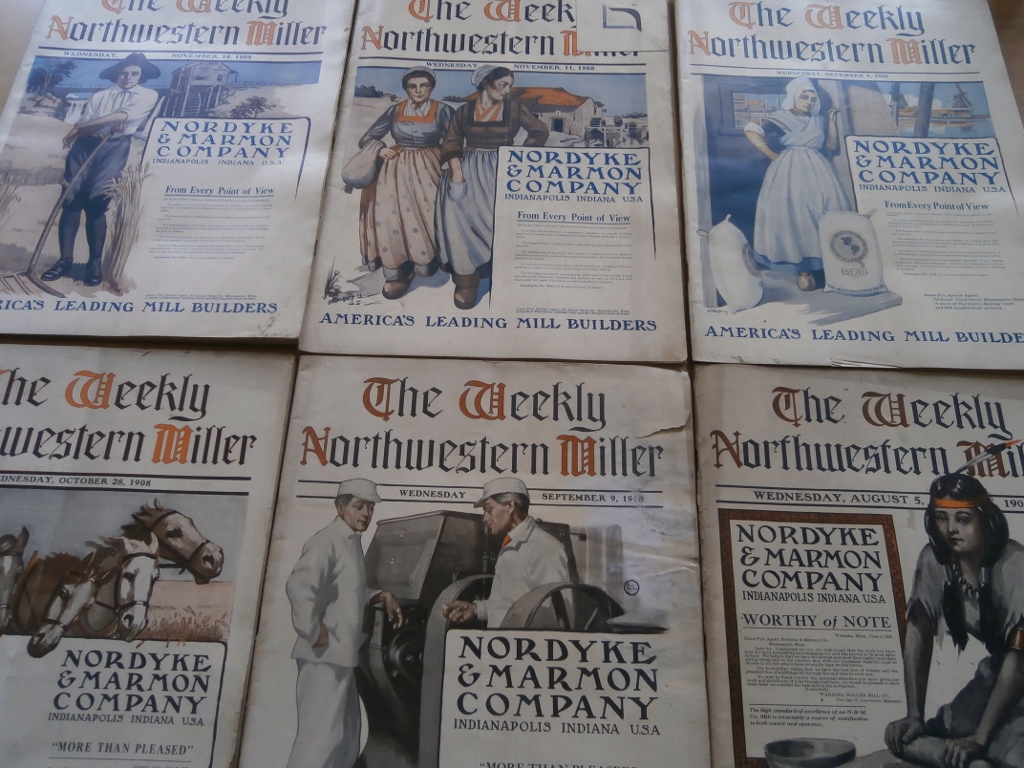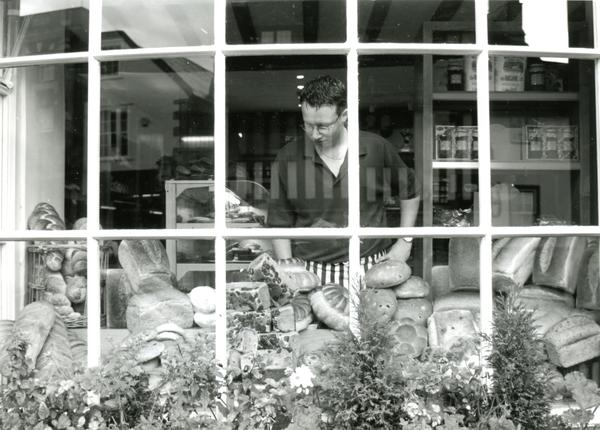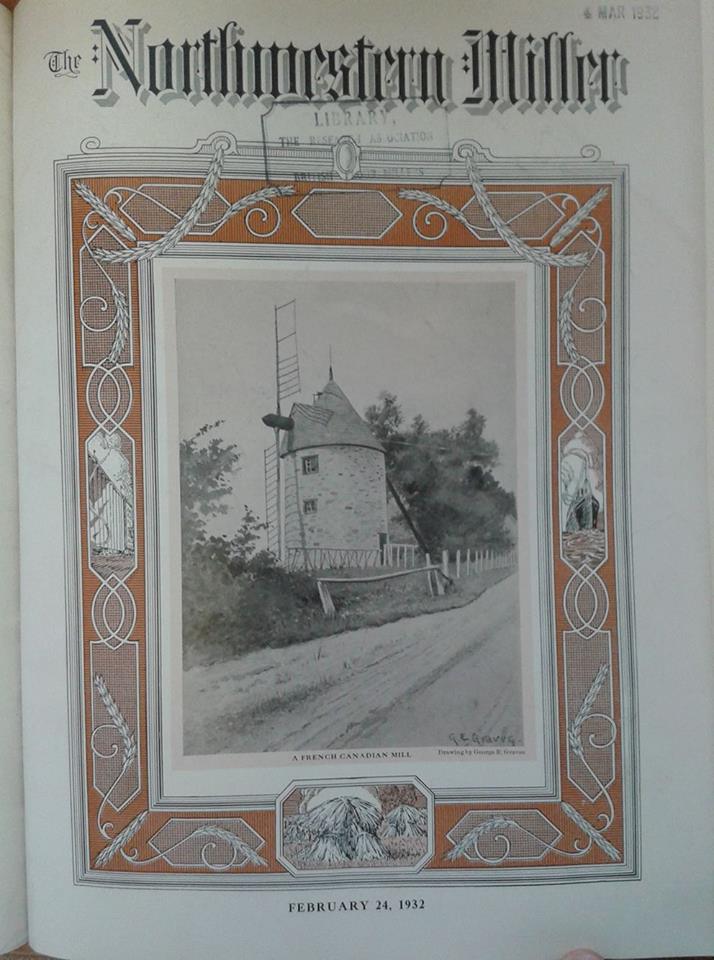From Mill to Shelf: Advertising
Once the flour has been made and transported away from the mill, it will hopefully be sold. However, the demand for flour and bread could vary and custom could not always be guaranteed. Therefore, it became necessary that millers and bakers advertised their products to guarantee sales.
History

The world of advertising and milling has a fairly recent history in Britain. The first adverts could be found in milling journals at the end of the 19th century but were for machinery and engineering companies, rather than the finished products. In contrast to this, The Northwestern Miller in America contained around 450-600 adverts per edition and included colour adverts for mills, bakeries and flour, not just machinery. Therefore, Britain was very much behind the US when it came to using advertising methods to promote goods and increase sales.
This has been described by the author Glyn Jones as he stated that ‘British millers slowly realised the importance of advertising but were not quick to learn how to do it’ (Jones, 2003, p.130). Whilst America had adverts in their publications in the 1800s, it took British millers till the 1920s to recognise the potential of advertising campaigns and even then were slow to implement it themselves. They learnt from the Daily Mail campaign for the consumption of ‘Standard Bread’. This was ‘bread made from at least 90% flour that is with only the coarse bran extracted’ (Hancock, p.28). It was argued that this bread would improve the health of the nation and it appeared to be a success as it ‘caught on very strongly and people were asking for standard bread everywhere’ (Hancock, p.28). This gave miller the opportunity to see the impact that adverts and newspaper campaigns could have on their industry. However, the campaign only had limited success as T. R. Over wrote that ‘after running for a few months the trade gradually began to fall’ whilst Hancock claimed that the ‘demand was maintained for a few years but eventually people went back to the white loaf’ (Over, p.2; Hancock, p.28). Despite its limited success, the campaign still showed the impact that advertising could have.
‘Eat More Bread’ Campaigns
The ‘Standard Bread’ Campaign was not the only campaign that took place during the first half of the 20th century. In 1923, the post-war British milling industry was suffering from a surplus of flour, both produced domestically and imported from abroad. It was decided that the only possibility to find a greater revenue for British flour was ‘to persuade the public to eat more bread’ (Jones, 2001, p.285). A similar campaign was reported to be taking place in America by Milling and it was having success. Therefore, Milling was hopeful and optimistic about a campaign succeeding in Britain but other publications and people were unconvinced. Sidney Leetham, a president of nabim, said ‘You cannot make people eat more bread than they want’ whilst The Miller was doubtful about whether it could succeed (Milling, 1923, p.310). Ultimately, Mr. Leetham and The Miller were proved correct as the campaign was deemed unsuccessful when no practical results could be found.
However, a few years later in 1925, the campaign was revitalised at the National Association Convention. An advertising consultant, Thomas Russell, was invited to give a talk about advertising and concluded with the ‘inevitable question. Will it pay? One thing is quite certain; it will not pay if you do not do it’ (Jones, p.294). His suggestion was that they produce ‘perfectly mouth-watering posters’, and that bakers ‘make their bread a little better’ to make it desirable to eat more (Jones, 2001, p.295). These techniques are similar to those used today but were never utilised at the time as the campaign never ran due to the proposed budget of £100,000 per year not being met. This all aptly demonstrates Jones’ claim that during the 1920s ‘British millers slowly realised the importance of advertising but were not quick to learn how to do it’. The history of the 1920’s shows the realisation that something must be done but a failure to implement it.

The 1930s, however, shows some improvement for the British milling industry and for other nations around the world. In 1934, A. E. Humphries told the NJIC that the ‘consumption [per head of the population] of flour, as well as of bread, has gone down materially’ (Jones, p.314). For the industry to survive, advertising was now a necessity. A variety of techniques were used: bread was endorsed as a key provider of energy by the Oxford and Cambridge boat crews and the Arsenal football team; and bread weeks were introduced, which involved posters, displays, and cookery exhibitions. Also, milling journals now contained adverts for products and all this combined meant that by ‘1935, there was a clearly modern flour milling industry in Britain’ (Jones, 2001, p.315).
Meanwhile, in other nations, America was making use of the new Kodak camera to produce glamourous photography alongside their slogan of ‘bread energy for vitality’. In Australia, they were having their own ‘Eat More Bread’ campaign in response to a surplus of wheat. This campaign was not that popular given that it was taking place during the Great Depression and families were struggling to buy any bread, let alone eating extra. This was described aptly by ‘No Dough’ when they wrote into The Shepparton Advertiser:
‘Mr. McLennan asks us to eat more bread. The public does not want to be told that. Very few people refuse to eat bread if they happen to be hungry and unfortunately, in this year too many of us are hungry.’
He blamed the bakers for making an unfair profit and reflected this in a verse included at the end of his letter:
‘The farmer toils from morn till night
To grow the golden grain,
The miller sees his humming mills,
And makes a goodly gain.
The baker bakes his snowy flour
And takes it on his round;
Consumers buy it sweet or sour,
At four pence for a pound.
“Eat more bread’ the millers sigh,
With tongues within their cheek;
“We want more bread”, the children cry’
So, whilst advertising could benefit the milling industry, not all campaigns were popular or successful.
Selling Techniques

So, what could help guarantee success in an advertising campaign? Which methods are best? The advertisements from The Northwestern Miller are most helpful when trying to answer these questions.
Within one edition, from 24 February 1932, numerous adverts for flour can be found. Different companies employed different methods to make their flour the most desirable. The adverts share some characteristics but also differ over others. For example, differences can be seen between targeting different audiences. ‘Pillsbury’s Bakery Flours’, ‘Sperry Flour Company’ and ‘Kelly’s Famous Flour’ were all appealing to commercial bakers rather than the home baker. Therefore, they focused on technical aspects and convenience: Pillsbury’s claimed that their flour had led to ‘a 25% increase in production per man in bakeries’ whilst Sperry Flour Company had branches conveniently located ‘for supreme service to every baker in the west’ (pp.489 & 491). By choosing a specific audience, companies can then highlight what that audience cares about, in this case, productivity and convenience, to help sell their product.
Another issue that both commercial and home bakers would care about was the quality of flour. This led to most companies claiming that their product was the best or the finest or has the highest grade. Some even included such superlative words in their name: ‘Kansas Best Flour’, ‘Wolf’s Premium Flour’; and ‘Gold Medal Flour’. The names themselves recommend the product so already does part of the advertising before anything else is done.
Another important role the name of a company could have, as well as recommending itself, is to be memorable. One way of doing this is to choose a figure or character, already known in their own rights, to name your flour after. For example, ‘Mother Hubbard Flour’ and ‘Robin Hood Flour’ are both easily remembered due to the use of characters already known.
This technique was one that Mr. E. L. Stancliff would have approved of. He thought that the ‘great mistake we millers have made in the past has been the general custom of discussing flour grades and flour markets with the dealer instead of placing our entire emphasis upon developing a kind of flour and a merchandising plan that will assure the dealer a profit’ (Martin, p.226). Naming your flour after a recognisable character was a merchandising plan that appeared to work.
Furthermore, the company that Mr. Stancliff was general manager of, the George P. Plant Milling Co., used another type of merchandising plan to this audience by focusing on the benefits their flour could have to their family life. The ‘Seal of Minnesota’ and ‘King Midas Flour’ adverts both contained the image of a happy baby or child whilst ‘Big Jo Flour’ contained the tag line ‘The Family Flour Trade is Discriminating’. Rather than focusing on the family to win over the housewife, Mr. Stancliff and the George P. Plant Milling Co. focused on something else with the creation of their new brand: Gingham Girl.
During the 19th century it was common practice for flour sacks to be reused in the creation of household goods, such as dishcloths. However, when the Great Depression hit in the 1930s, flour sacks then became a cheap way to get material for clothes. It was this market that Mr Stancliff and Gingham Girl was trying to exploit. Their flour was packaged in sacks made of gingham material with the ‘principal colours…pink and white and blue and white’ (Martin, p.226). Whilst there was printing on the bag, this was done ‘by a special patent process, using soluble vegetable inks, so that the brands will rinse out with the use of regular laundry soap and water’ (Martin, p.226). This would leave the material blank and ready to be made into a dress. For the thrifty housewife struggling to clothe herself and her family in the midst of the Depression, this tactic was a popular one and many other companies soon started putting their flour in bright colourful sacks for the same use. As a merchandising plan, it appeared to work very well.
Indeed, it was not just a method used in America. Within his work about Ireland, Campion stated that ‘The cotton bags were very much a reusable packaging material and few were dumped. Many 8- or 10- stone cotton flour bags became sheets with brand names such as ‘Purity’, ‘Hearts Delight’ or ‘Magnificent’ stamped on them. Smaller bags became dishcloths, pillow cases, straining bags for crab apple jelly, or even shirts’ (Campion, p.155). Therefore, as strange as it seems, it was not always the flour itself that made a product desirable but the items that came with it.

This tactic of having more than just flour sold by a brand was used in many other ways. The production of recipe books to complement the flour was and is a common practice. Other types of products also do well especially when a brand has a recognisable icon or mascot associated with them. In America, the brand ‘Pillsbury’ debuted Doughboy in 1965, one year after ‘Homepride’ in Britain had introduced Fred the Flour Grader in his notable bowler hat. In Ireland, ‘Odlums’ owl makes each product instantly recognisable whilst also referring to their heritage as the owl had initially been part of their family crest. These icons make brands immediately recognisable and today with the internet, TV adverts, and traditional posters, mascots like this can play multiple roles in appealing to different audiences and making a brand memorable.
So from the 1920s to today, advertising campaigns have played an influential role on the milling industry. From getting people to eat ‘Standard Bread’ to just more bread in general and then to choose a particular brand, advertising campaigns have covered them all. A variety of techniques are used and it all helped in allowing the milling industry to grow and for roller milling to continue to progress.
Sources:
‘Eat More Bread’, The Shepparton Advertiser (1 September 1930), p.4.
‘The question of output’, Milling (April, 1923), p.310.
Hancock, Philip, ‘Extracts from “Rambling Recollections of a Rural Miller”’ (1980): FULL-22162.
http://australianfoodtimeline.com.au/eat-more-bread-campaign/
http://homeprideflour.co.uk/our-heritage
https://www.pillsbury.com/doughboy
Martin, W. G., ‘Gingham is used for Flour Sacks’, The Northwestern Miller (15 April 1925), p.226.
Over, T. R., Fifty Years of Milling: OVER-007.
The Northwestern Miller (24 February 1932).
